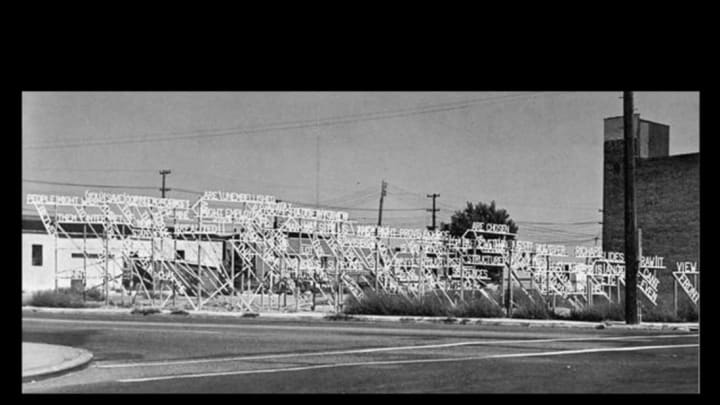Sentence diagramming was once a widespread technique for teaching kids how to analyze the structure of a sentence. If you had to do it in school, you either loved it or you hated it. Most kids hated it. But for the kids who loved it, it made language into an orderly puzzle, complicated but solvable, where words clicked into interlocking pairs, groups, and chunks, until a picture of the hidden architecture of sentences emerged. That architecture, when exposed, can be beautiful. It’s no wonder that sentence diagrams have made their way into art. Here are 6 creative uses of sentence diagramming.
1. Our Own Effort (Proust)
Click to enlarge. Image courtesy of Nicholas Knight.
Artist Nicholas Knight features sentence diagrams in many of his drawings, collages, and wall installations. He diagrams quotes from famous artists and thinkers that highlight the interplay between meaning and structure. This work, Our Own Effort (Proust), represents Proust’s statement that “what we have not had to decipher and to clarify by our own effort, what was clear before we came, does not belong to us.” You can figure this out, through the clarifying effects of your own effort, if you closely study this print that at first appears to be a colorful subway map.
2. close
Image courtesy of Kelly Sherman and Barbara Krakow Gallery.
Artist Kelly Sherman has produced a series of works diagramming lines of original poetry. As she says in her artist’s statement, “reiterating or undermining the sentences’ content, the work in this series addresses the hierarchies, structures and overwhelming eloquence of language.” In this work, close, the modifiers of the adjective “close” in “so close like breath” are obscured to different degrees by layers of vellum, adding another element of visual structure.
3. 9 artists/9 spaces
Photo courtesy of lnkall.com.
In 1970, the Minnesota State Arts Council organized a show of art in public spaces called 9 artists/9 spaces. The invited artists prepared their pieces, but almost none of the works were ever seen because, as Peggy Weil explains in this unbelievable history of the event, “one by one each piece fell victim to controversy or mishap.” One was vandalized, one was dismantled by the FBI, and one was shut down after a giant cache of explosives were discovered in the basement of the building where it was installed. The piece Robert Cummings created, a giant sculpture of diagrammed sentences made up of 1150 painted letters on wooden scaffold, was destroyed when a semi truck crashed into it. As if that wasn’t unlucky enough, the camera of the photographer who was at that very moment photographing the piece was also destroyed, along with the detailed images he was in the middle of capturing for posterity.
4. "Which Sentences Are We Diagramming"
Comic by Kevin Huizenga; image via Austin Kleon.
In “Which Sentences are We Diagramming,” Kevin Huizenga illustrates the frustration of parsing confusing sentences. He tries to untangle structure through everything from sentence diagrams and lists to base-running and Mad Libs. The full version of this comic is at What Things Do.
5. "a loving heart is the beginning of all knowledge"
Image courtesy of Follow Your Gnose
This post from Follow Your Gnose gives instructions for making your own sentence diagram mobile. The sentence pictured here, “a loving heart is the beginning of all knowledge,” is from Thomas Carlyle. With some card stock, wooden dowels, fishing line, and glue you too could set some delicately balanced clauses spinning in the breeze.
6. "cross-stitching is contagious"
Image courtesy of Embroiderbee
The straight lines of sentence diagrams lend themselves well to anything made on a grid. Embroiderbee offers a huge selection of free needlework patterns, including this cross stitch sentence diagram.
